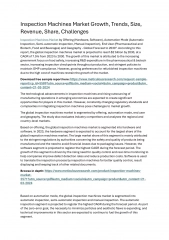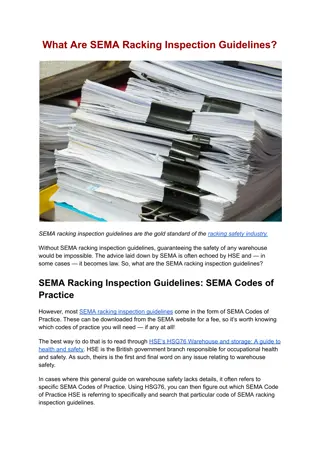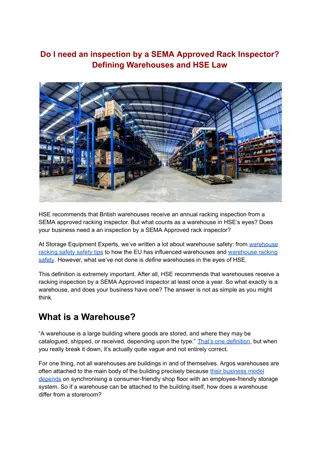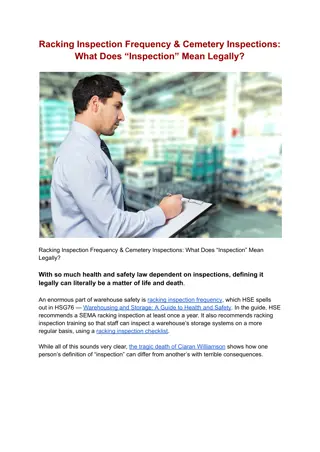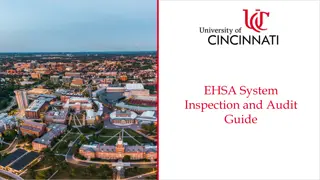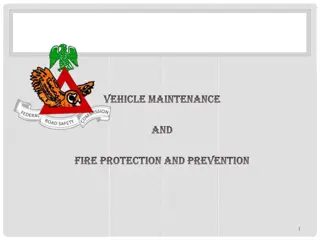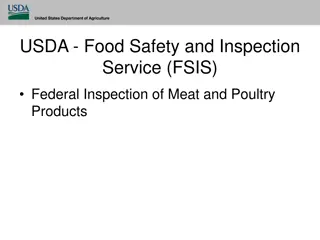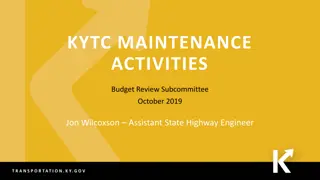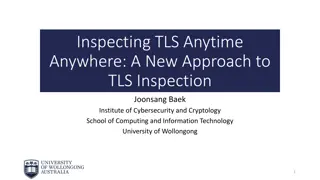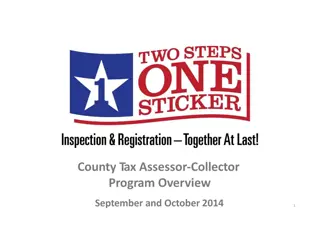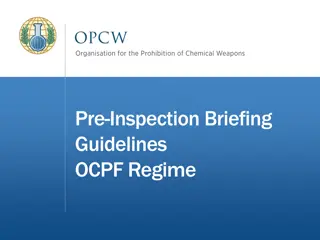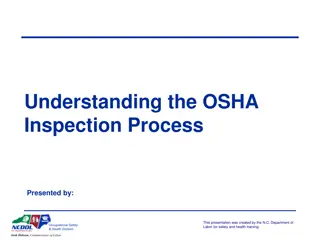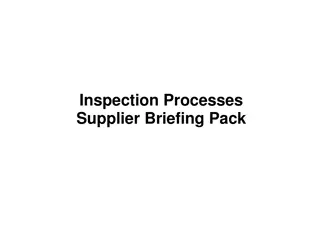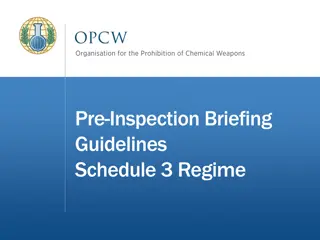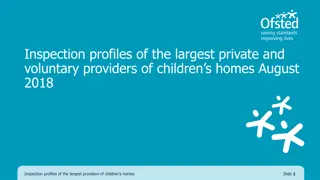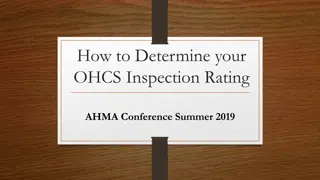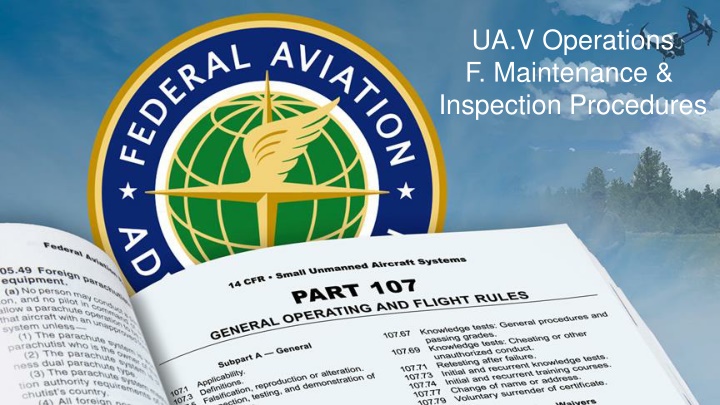
Maintenance and Inspection Procedures for sUAS Operations
Learn about the importance of maintenance and inspection procedures for small Unmanned Aircraft Systems (sUAS). Find guidance on preflight inspection techniques and risk management, as well as the significance of basic maintenance and record-keeping. Understand the requirements for maintaining sUAS in a safe operating condition, including scheduled and unscheduled maintenance tasks. Discover the responsibilities of the remote Pilot In Command (PIC) in ensuring the sUAS is flight-ready. Stay informed about manufacturer instructions for maintenance and the benefits of recordkeeping in managing sUAS maintenance effectively.
Download Presentation

Please find below an Image/Link to download the presentation.
The content on the website is provided AS IS for your information and personal use only. It may not be sold, licensed, or shared on other websites without obtaining consent from the author. If you encounter any issues during the download, it is possible that the publisher has removed the file from their server.
You are allowed to download the files provided on this website for personal or commercial use, subject to the condition that they are used lawfully. All files are the property of their respective owners.
The content on the website is provided AS IS for your information and personal use only. It may not be sold, licensed, or shared on other websites without obtaining consent from the author.
E N D
Presentation Transcript
UA.V Operations F. Maintenance & Inspection Procedures
Remote Pilot Airman Certification Standards F. Maintenance and Inspection Procedures (*) F. Maintenance and Inspection Procedures (*) Task AC 107-2 References To determine that the applicant is knowledgeable in sUAS maintenance and inspection procedures. The applicant demonstrates understanding of: Objective Knowledge Basic maintenance. UA.V.F.K1 UA.V.F.K2 UA.V.F.K3 Preflight inspection Techniques to mitigate mechanical failures of all elements used in sUAS operations, such as the battery and/or any device(s) used to operate the sUAS. Appropriate record keeping. UA.V.F.K4 UA.V.F.K5 Risk Risk Management Management Persons that may perform maintenance on an sUAS. [Reserved] [Not applicable] Skills Skills
Basic maintenance 5.5 sUAS Maintenance, Inspections, and Condition for Safe Operation. An sUAS must be maintained in a condition for safe operation. Prior to flight, the remote PIC is responsible for conducting a check of the sUAS and verifying that it is actually in a condition for safe operation. Guidance regarding how to determine that an sUAS is in a condition for safe operation is found in Chapter 7, sUAS Maintenance and Inspection. AC 107.2 Small Unmanned Aircraft Systems UA.V.F.K1
Basic maintenance 7.2 Maintenance. sUAS maintenance includes scheduled and unscheduled overhaul, repair, inspection, modification, replacement, and system software upgrades of the sUAS and its components necessary for flight. Whenever possible, the operator should maintain the sUAS and its components in accordance with manufacturer s instructions. The aircraft manufacturer may provide the maintenance program, or, if one is not provided, the applicant may choose to develop one. See paragraph 7.3.5 for suggested benefits of recordkeeping. AC 107.2 Small Unmanned Aircraft Systems UA.V.F.K1
Basic maintenance 7.2.1 Scheduled Maintenance. The sUAS manufacturer may provide documentation for scheduled maintenance of the entire UA and associated system equipment. There may be components of the sUAS that are identified by the manufacturer to undergo scheduled periodic maintenance or replacement based on time-in-service limits (such as flight hours, cycles, and/or the calendar-days). All manufacturer scheduled maintenance instructions should be followed in the interest of achieving the longest and safest service life of the sUAS. 7.2.1.1 If there are no scheduled maintenance instructions provided by the sUAS manufacturer or component manufacturer, the operator should establish a scheduled maintenance protocol. This could be done by documenting any repair, modification, overhaul, or replacement of a system component resulting from normal flight operations, and recording the time-in-service for that component at the time of the maintenance procedure. Over time, the operator should then be able to establish a reliable maintenance schedule for the sUAS and its components. AC 107.2 Small Unmanned Aircraft Systems UA.V.F.K1
Basic maintenance 7.2.2 Unscheduled Maintenance. During the course of a preflight inspection, the remote PIC may discover that an sUAS component is in need of servicing (such as lubrication), repair, modification, overhaul, or replacement outside of the scheduled maintenance period as a result of normal flight operations or resulting from a mishap. In addition, the sUAS manufacturer or component manufacture may require an unscheduled system software update to correct a problem. In the event such a condition is found, the remote PIC should not conduct flight operations until the discrepancy is corrected. AC 107.2 Small Unmanned Aircraft Systems UA.V.F.K1
Preflight inspection 7.3 Preflight Inspection. Before each flight, the remote PIC must inspect the sUAS to ensure that it is in a condition for safe operation, such as inspecting for equipment damage or malfunction(s). The preflight inspection should be conducted in accordance with the sUAS manufacturer s inspection procedures when available (usually found in the manufacturer s owner or maintenance manual) and/or an inspection procedure developed by the sUAS owner or operator. AC 107.2 Small Unmanned Aircraft Systems UA.V.F.K2
Preflight inspection 7.3.4 Preflight Inspection Items. Even if the sUAS manufacturer has a written preflight inspection procedure, it is recommended that the remote PIC ensure that the following inspection items are incorporated into the preflight inspection procedure required by part 107 to help the remote PIC determine that the sUAS is in a condition for safe operation. The preflight inspection should include a visual or functional check of the following items: 1. Visual condition inspection of the UAS components; 2. Airframe structure (including undercarriage), all flight control surfaces, and linkages; 3. Registration markings, for proper display and legibility; 4. Moveable control surface(s), including airframe attachment point(s); 5. Servo motor(s), including attachment point(s); 6. Propulsion system, including powerplant(s), propeller(s), rotor(s), ducted fan(s), etc.; 7. Verify all systems (e.g., aircraft and control unit) have an adequate energy supply for the intended operation and are functioning properly; 8. Avionics, including control link transceiver, communication/navigation equipment, and antenna(s); 9. Calibrate UAS compass prior to any flight; 10. Control link transceiver, communication/navigation data link transceiver, and antenna(s); AC 107.2 Small Unmanned Aircraft Systems UA.V.F.K2
Preflight inspection 11. Display panel, if used, is functioning properly; 12. Check ground support equipment, including takeoff and landing systems, for proper operation; 13. Check that control link correct functionality is established between the aircraft and the CS; 14. Check for correct movement of control surfaces using the CS; 15. Check onboard navigation and communication data links; 16. Check flight termination system, if installed; 17. Check fuel for correct type and quantity; 18. Check battery levels for the aircraft and CS; 19. Check that any equipment, such as a camera, is securely attached; 20. Verify communication with UAS and that the UAS has acquired GPS location from at least four satellites; 21. Start the UAS propellers to inspect for any imbalance or irregular operation; 22. Verify all controller operation for heading and altitude; 23. If required by flight path walk through, verify any noted obstructions that may interfere with the UAS; and 24. At a controlled low altitude, fly within range of any interference and recheck all controls and stability. AC 107.2 Small Unmanned Aircraft Systems UA.V.F.K2
Techniques to mitigate mechanical failures of all elements used in sUAS operations, such as the battery and/or any device(s) used to operate the sUAS. APPENDIX C. sUAS MAINTENANCE AND INSPECTION BEST PRACTICES In the interest of assisting varying background levels of sUAS knowledge and skill, below is a chart offering conditions that, if noticed during a preflight inspection or check, may support a determination that the UAS is not in a condition for safe operation. Further inspection to identify the scope of damage and extent of possible repair needed to remedy the unsafe condition may be necessary prior to flight AC 107.2 Small Unmanned Aircraft Systems UA.V.F.K3
Appropriate record keeping 7.3.5 Benefits of Recordkeeping. sUAS owners and operators may find recordkeeping to be beneficial. This could be done by documenting any repair, modification, overhaul, or replacement of a system component resulting from normal flight operations, and recording the time-in-service for that component at the time of the maintenance procedure. Over time, the operator should then be able to establish a reliable maintenance schedule for the sUAS and its components. Recordkeeping that includes a record of all periodic inspections, maintenance, preventative maintenance, repairs, and alterations performed on the sUAS could be retrievable from either hardcopy and/or electronic logbook format for future reference. This includes all components of the sUAS, including: small UA, CS, launch and recovery equipment, C2 link equipment, payload, and any other components required to safely operate the sUAS. Recordkeeping of documented maintenance and inspection events reinforces owner/operator responsibilities for airworthiness through systematic condition for safe flight determinations. Maintenance and inspection recordkeeping provides retrievable empirical evidence of vital safety assessment data defining the condition of safety-critical systems and components supporting the decision to launch. Recordkeeping of an sUAS may provide essential safety support for commercial operators that may experience rapidly accumulated flight operational hours/cycles. Methodical maintenance and inspection data collection can prove to be very helpful in the tracking of sUAS component service life, as well as systemic component, equipage, and structural failure events. AC 107.2 Small Unmanned Aircraft Systems UA.V.F.K4
Persons that may perform maintenance on an sUAS 7.2.3 Performing Maintenance. In some instances, the sUAS or component manufacturer may require certain maintenance tasks be performed by the manufacturer or by a person or facility (personnel) specified by the manufacturer. It is highly recommended that the maintenance be performed in accordance with the manufacturer s instructions. However, if the operator decides not to use the manufacturer or personnel recommended by the manufacturer and is unable to perform the required maintenance, the operator should 6/21/16 AC 107-2 7-2 consider the expertise of maintenance personnel familiar with the specific sUAS and its components. In addition, though not required, the use of certificated maintenance providers are encouraged, which may include repair stations, holders of mechanic and repairman certificates, and persons working under the supervision of these mechanics and repairman. 7.2.3.1 If the operator or other maintenance personnel are unable to repair, modify, or overhaul an sUAS or component back to its safe operational specification, then it is advisable to replace the sUAS or component with one that is in a condition for safe operation. It is important that all required maintenance be completed before each flight, and preferably in accordance with the manufacturer s instructions or, in lieu of that, within known industry best practices. AC 107.2 Small Unmanned Aircraft Systems UA.V.F.K5

